A Simple and Effective Colorimetric Assay for Glucose Based on MnO2 Nanosheets
Abstract
:1. Introduction
2. Experimental
2.1. Chemicals and Materials
2.2. Apparatus
2.3. Synthesis of MnO2 Nanosheets
2.4. Reaction between H2O2 and MnO2 Nanosheets
2.5. Determination of Glucose
3. Results and Discussion
3.1. Characterization of MnO2 Nanosheets
3.2. Feasibility of the Detection of Glucose Using MnO2 Nanosheets
3.3. Optimization of Experimental Conditions
3.4. Analytical Performance of the Sensing of Glucose
3.5. Application of Visual Detection in Human Serum Samples
4. Conclusions
Author Contributions
Acknowledgments
Conflicts of Interest
References
- Hu, Y.; Cheng, H.; Zhao, X.; Wu, J.; Muhammad, F.; Lin, S.; He, J.; Zhou, L.; Zhang, C.; Deng, Y.; et al. Surface-Enhanced Raman Scattering Active Gold Nanoparticles with Enzyme-Mimicking Activities for Measuring Glucose and Lactate in Living Tissues. ACS Nano 2017, 11, 5558–5566. [Google Scholar] [CrossRef] [PubMed]
- Yu, D.; Wang, P.; Zhao, Y.; Fan, A. Iodophenol blue-enhanced luminol chemiluminescence and its application to hydrogen peroxide and glucose detection. Talanta 2016, 146, 655–661. [Google Scholar] [CrossRef] [PubMed]
- Tierney, M.; Kim, H.; Burns, M.; Tamada, J.; Potts, R. Electroanalysis of Glucose in Transcutaneously Extracted Samples. Electroanalysis 2015, 12, 666–671. [Google Scholar] [CrossRef]
- Liu, L.; Ma, Q.; Li, Y.; Liu, Z.; Su, X. A novel signal-off electrochemiluminescence biosensor for the determination of glucose based on double nanoparticles. Biosens. Bioelectron. 2015, 63, 519–524. [Google Scholar] [CrossRef] [PubMed]
- Yuan, J.; Cen, Y.; Kong, X.; Wu, S.; Liu, C.; Yu, R.; Chu, X. MnO2-Nanosheet-Modified Upconversion Nanosystem for Sensitive Turn-On Fluorescence Detection of H2O2 and Glucose in Blood. ACS Appl. Mater. Interfaces 2015, 7, 10548–10555. [Google Scholar] [CrossRef] [PubMed]
- Muhr, V.; Buchnera, M.; Hirsch, T.; Jovanović, D.; Dolić, S.; Dramićanin, M.; Wolfbeis, O. Europium-doped GdVO4 nanocrystals as a luminescent probe for hydrogen peroxide and for enzymatic sensing of glucose. Sens. Actuators B Chem. 2017, 241, 349–356. [Google Scholar] [CrossRef]
- Chang, Q.; Tang, H. Optical determination of glucose and hydrogen peroxide using a nanocomposite prepared from glucose oxidase and magnetite nanoparticles immobilized on graphene oxide. Microchim. Acta 2014, 181, 527–534. [Google Scholar] [CrossRef]
- Mu, J.; He, Y.; Wang, Y. Copper-incorporated SBA-15 with peroxidase-like activity and its application for colorimetric detection of glucose in human serum. Talanta 2016, 148, 22–28. [Google Scholar] [CrossRef] [PubMed]
- Xiong, Y.; Zhang, Y.; Rong, P.; Yang, J.; Wang, W.; Liu, D. A high-throughput colorimetric assay for glucose detection based on glucose oxidase-catalyzed enlargement of gold nanoparticles. Nanoscale 2015, 7, 15584–15588. [Google Scholar] [CrossRef] [PubMed]
- Cai, S.; Han, Q.; Qi, C.; Lian, Z.; Jia, X.; Yang, R.; Wang, C. Pt74Ag26 nanoparticle-decorated ultrathin MoS2 nanosheets as novel peroxidase mimics for highly selective colorimetric detection of H2O2 and glucose. Nanoscale 2016, 8, 3685–3693. [Google Scholar] [CrossRef] [PubMed]
- Gabriel, E.; Garcia, P.; Cardoso, T.; Lopes, F.; Martinsa, F.; Coltro, W. Highly sensitive colorimetric detection of glucose and uric acid in biological fluids using chitosan-modified paper microfluidic devices. Analyst 2016, 141, 4749–4756. [Google Scholar] [CrossRef] [PubMed]
- Liu, F.; He, J.; Zeng, M.; Hao, J.; Guo, Q.; Song, Y.; Wang, L. Cu-hemin metal-organic frameworks with peroxidase-like activity as peroxidase mimics for colorimetric sensing of glucose. J. Nanoparticle Res. 2016, 18, 1–9. [Google Scholar] [CrossRef]
- Jin, L.; Meng, Z.; Zhang, Y.; Cai, S.; Zhang, Z.; Li, C.; Shang, L.; Shen, Y. Ultrasmall Pt Nanoclusters as Robust Peroxidase Mimics for Colorimetric Detection of Glucose in Human Serum. ACS Appl. Mater. Interfaces 2017, 9, 10027–10033. [Google Scholar] [CrossRef] [PubMed]
- Xiang, D.; Yin, L.; Ma, J.; Guo, E.; Li, Q.; Li, Z.; Liu, K. Amperometric hydrogen peroxide and glucose biosensor based on NiFe2/ordered mesoporous carbon nanocomposites. Analyst 2015, 140, 644–653. [Google Scholar] [CrossRef] [PubMed]
- Han, L.; Zeng, L.; Wei, M.; Li, C.; Liu, A. V2O3-Ordered Mesoporous Carbon Composite with Novel Peroxidase-Like Activity towards Glucose Colorimetric Assay. Nanoscale 2015, 7, 11678–11685. [Google Scholar] [CrossRef] [PubMed]
- Kim, M.I.; Cho, D.; Park, H.G. Colorimetric Quantification of Glucose and Cholesterol in Human Blood Using a Nanocomposite Entrapping Magnetic Nanoparticles and Oxidases. J. Nanosci. Nanotechnol. 2015, 15, 7955–7961. [Google Scholar] [CrossRef] [PubMed]
- Sies, H. Hydrogen peroxide as a central redox signaling molecule in physiological oxidative stress: Oxidative eustress. Redox Biol. 2017, 11, 613–619. [Google Scholar] [CrossRef] [PubMed]
- Lennicke, C.; Rahn, J.; Lichtenfels, R.; Wessjohann, L.; Seliger, B. Hydrogen peroxide—Production, fate and role in redox signaling of tumor cells. Cell Commun. Signal. 2015, 13, 39. [Google Scholar] [CrossRef] [PubMed]
- Niethammer, P.; Grabher, C.; Look, A.T.; Mitchison, T.J. A tissue-scale gradient of hydrogen peroxide mediates rapid wound detection in zebrafish. Nature 2009, 459, 996–999. [Google Scholar] [CrossRef] [PubMed] [Green Version]
- Satooka, H.; Hara-Chikuma, M. Aquaporin-3 Controls Breast Cancer Cell Migration by Regulating Hydrogen Peroxide Transport and Its Downstream Cell Signaling. Mol. Cell. Biol. 2016, 36, 1206–1218. [Google Scholar] [CrossRef] [PubMed] [Green Version]
- Lux, C.D.G.; Joshi-Barr, S.; Nguyen, T.; Mahmoud, E.; Schopf, E.; Fomina, N.; Almutairi, A. Biocompatible Polymeric Nanoparticles Degrade and Release Cargo in Response to Biologically Relevant Levels of Hydrogen Peroxide. J. Am. Chem. Soc. 2012, 134, 15758–15764. [Google Scholar] [CrossRef] [Green Version]
- Mizutani, F.; Ohta, E.; Mie, Y.; Niwa, O.; Yasukawa, T. Enzyme immunoassay of insulin at picomolar levels based on the coulometric determination of hydrogen peroxide. Sens. Actuators B Chem. 2009, 135, 304–308. [Google Scholar] [CrossRef]
- Zhou, J.; Gu, J.; Tian, C.; Jiang, D.; Chen, Y.; Xi, K. Co3O4-cored carbon dots for chemiluminescence analysis of intracellular hydrogen peroxide. RSC Adv. 2016, 6, 39480–39483. [Google Scholar] [CrossRef]
- Ling, Y.; Zhang, N.; Qu, F.; Wen, T.; Gao, Z.; Li, N.; Luo, H. Fluorescent detection of hydrogen peroxide and glucose with polyethyleneimine-templated Cu nanoclusters. Spectrochim. Acta Part A Mol. Biomol. Spectrosc. 2014, 118, 315–320. [Google Scholar] [CrossRef] [PubMed]
- Rau, J.E.; Fischer, U. In-gel detection of L-amino acid oxidases based on the visualisation of hydrogen peroxide production. J. Microbiol. Methods 2011, 85, 228–229. [Google Scholar] [CrossRef] [PubMed]
- Kim, M.C.; Kwak, J.; Lee, S.Y. Sensing of Uric Acid via Cascade Catalysis of Uricase and a Biomimetic Catalyst. Sens. Actuators B Chem. 2016, 232, 744–749. [Google Scholar] [CrossRef]
- Zhang, Z.; Zhang, X.; Liu, B.; Liu, J. Molecular Imprinting on Inorganic Nanozymes for Hundred-fold Enzyme Specificity. J. Am. Chem. Soc. 2017, 139, 5412–5419. [Google Scholar] [CrossRef] [PubMed]
- Liu, B.; Han, X.; Liu, J. Iron oxide nanozyme catalyzed synthesis of fluorescent polydopamine for light-up Zn2+ detection. Nanoscale 2016, 8, 13620–13626. [Google Scholar] [CrossRef] [PubMed]
- Liu, B.; Sun, Z.; Huang, P.; Liu, J. Hydrogen Peroxide Displacing DNA from Nanoceria: Mechanism and Detection of Glucose in Serum. J. Am. Chem. Soc. 2015, 137, 1290–1295. [Google Scholar] [CrossRef] [PubMed]
- Lei, J.; Lu, X.; Wang, W.; Bian, X.; Xue, Y.; Wang, C.; Li, L. Fabrication of MnO2/graphene oxide composite nanosheets and their application in hydrazine detection. RSC Adv. 2012, 2, 2541–2544. [Google Scholar] [CrossRef]
- Liu, Z.; Cai, X.; Lin, X.; Zheng, Y.; Wu, Y.; Chen, P.; Weng, S.; Lin, L.; Lin, X. Signal-on fluorescent sensor based on GQDs–MnO2 composite for glutathione. Anal. Methods 2016, 8, 2366–2374. [Google Scholar] [CrossRef]
- Zheng, L.; Yu, H. Manganese dioxide nanosheets as an optical probe for photometric determination of free chlorine. Microchim. Acta 2016, 183, 2229–2234. [Google Scholar] [CrossRef]
- Huang, Z.; Yang, J.; Zhang, L.; Geng, X.; Ge, J.; Hu, Y.; Li, Z. A novel one-step colorimetric assay for highly sensitive detection of glucose in serum based on MnO2 nanosheets. Anal. Methods 2017, 9, 4275–4281. [Google Scholar] [CrossRef]
- Zhao, Z.; Fan, H.; Zhou, G.; Bai, H.; Liang, H.; Wang, R.; Zhang, X.; Tan, W. Activatable fluorescence/mri bimodal platform for tumor cell imaging via MnO2 nanosheet-aptamer nanoprobe. J. Am. Chem. Soc. 2014, 136, 11220–11223. [Google Scholar] [CrossRef] [PubMed]
- Zhao, G.; Li, J.; Ren, X.; Hu, J.; Hu, W.; Wang, X. Highly active MnO2 nanosheet synthesis from graphene oxide templates and their application in efficient oxidative degradation of methylene blue. RSC Adv. 2013, 3, 12909–12914. [Google Scholar] [CrossRef]
- Deng, R.; Xie, X.; Vendrell, M.; Chang, Y.; Liu, X. Intracellular Glutathione Detection Using MnO2-Nanosheet-Modified Upconversion Nanoparticles. J. Am. Chem. Soc. 2011, 133, 20168–20171. [Google Scholar] [CrossRef] [PubMed]
- Li, L.; Li, R.; Gai, S.; Ding, S.; He, F.; Zhang, M.; Yang, P. MnO2 Nanosheets Grown on Nitrogen-Doped Hollow Carbon Shells as a High-Performance Electrode for Asymmetric Supercapacitors. Chemistry 2015, 21, 7119–7126. [Google Scholar] [CrossRef] [PubMed]
- Yang, Y.; Yuan, W.; Li, S.; Yang, X.; Xu, J.; Jiang, Y. Manganese dioxide nanoparticle enrichment in porous conducting polymer as high performance supercapacitor electrode materials. Electrochim. Acta 2015, 165, 323–329. [Google Scholar] [CrossRef]
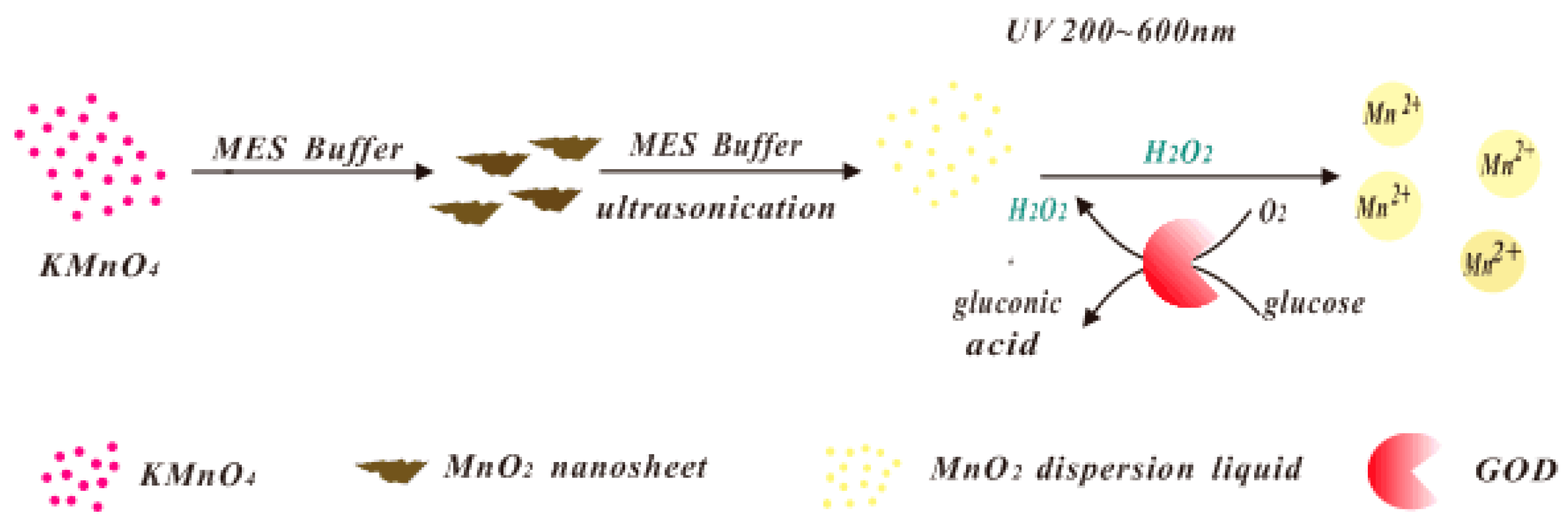

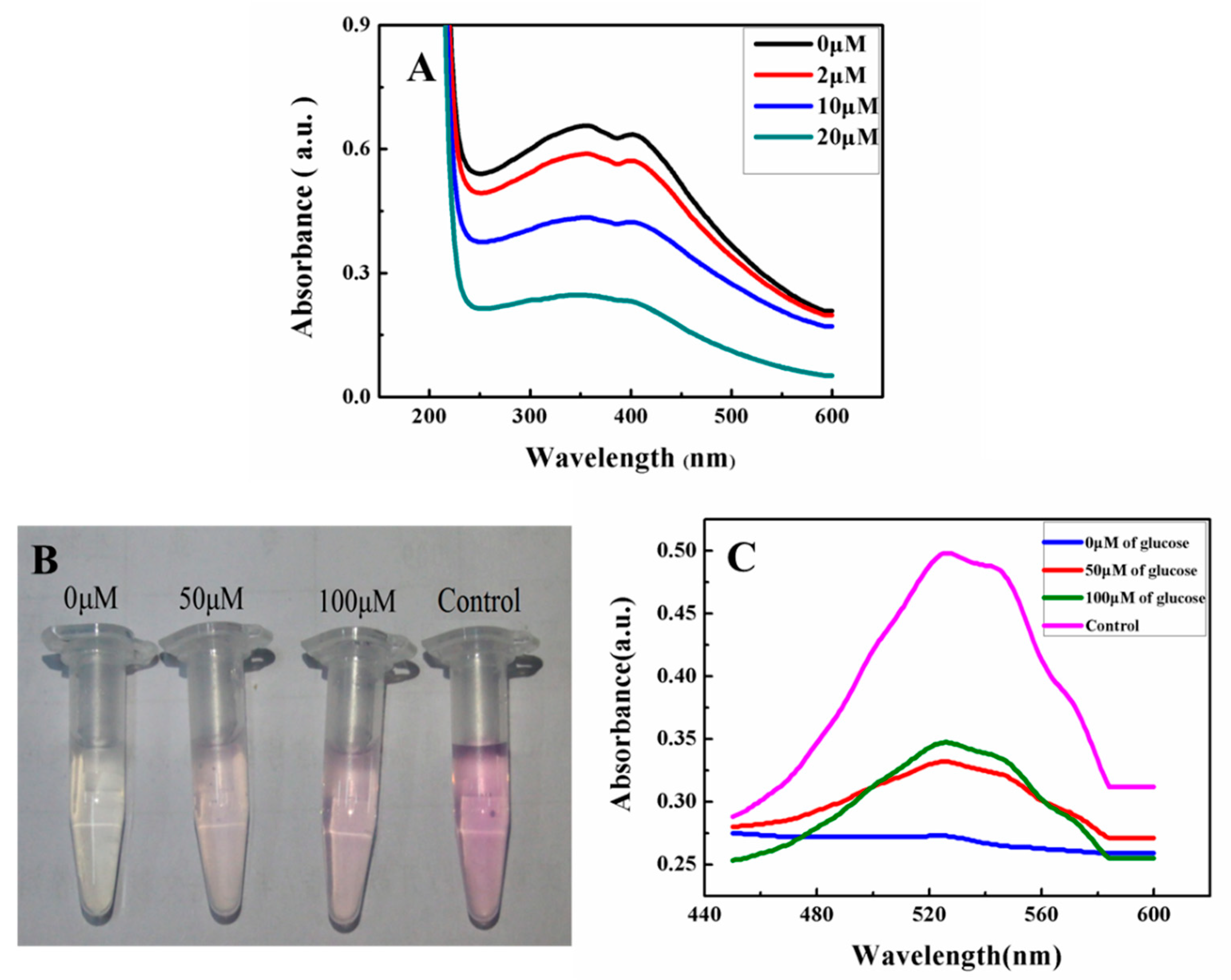
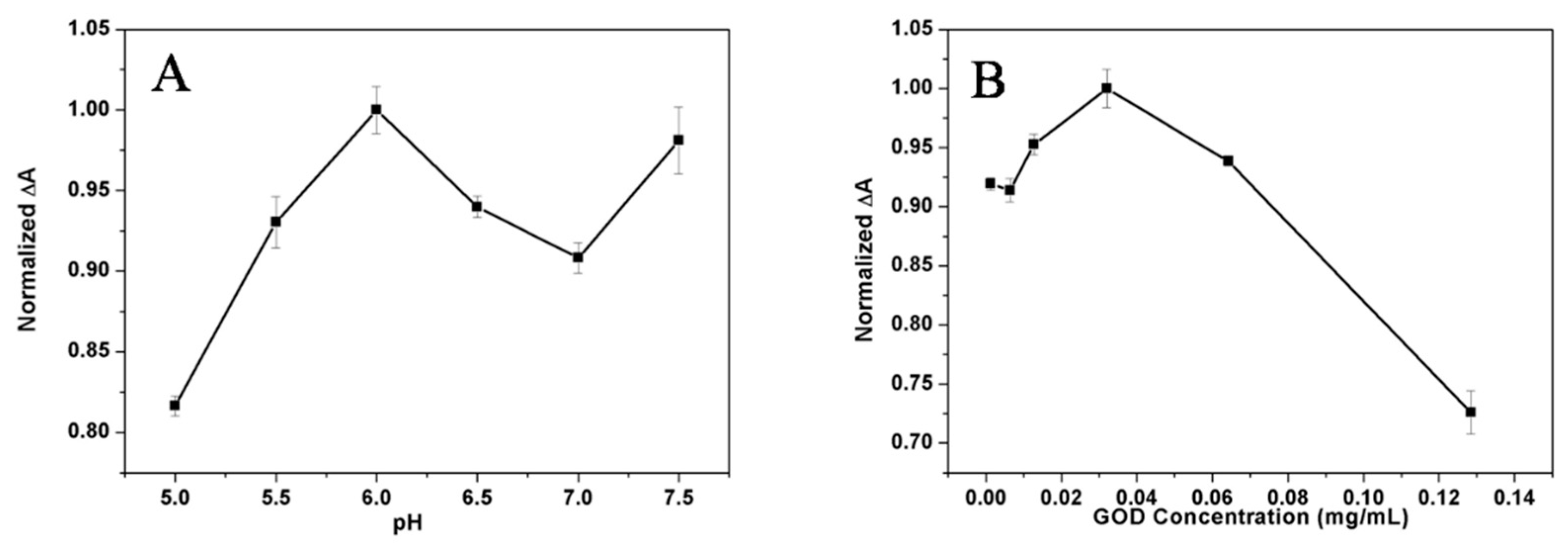

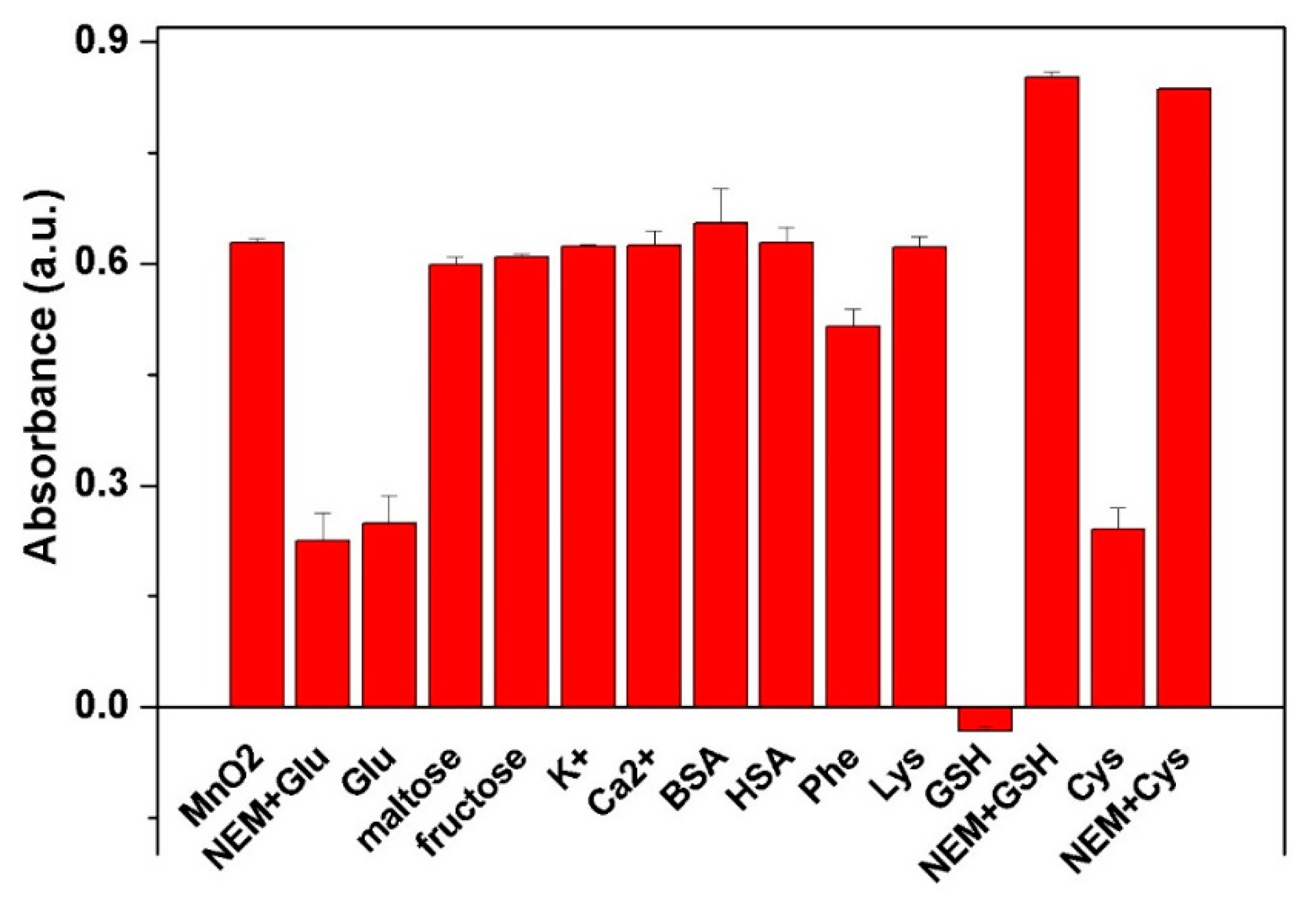
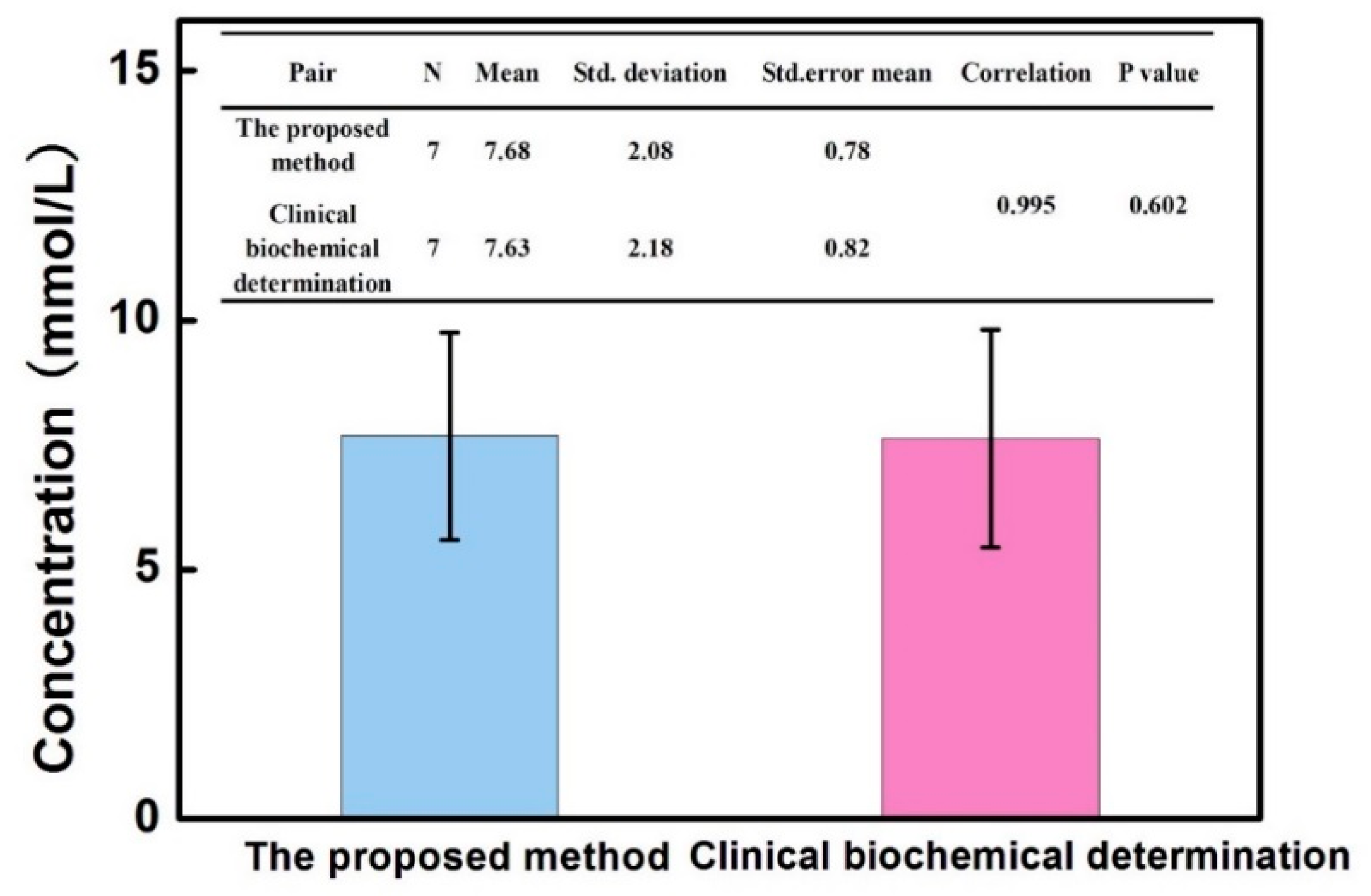
| Samples | Found by the Proposed Method (mmol/L) | RSD (%) (n = 3) | Found by Clinical Biochemical Determination (mmol/L) | Relative Errors (%) |
|---|---|---|---|---|
| 1 | 5.64 | 8.1 | 5.52 | 2.17 |
| 2 | 4.58 | 4.3 | 4.52 | 0.88 |
| 3 | 8.68 | 2.0 | 8.99 | 3.34 |
| 4 | 9.72 | 1.4 | 9.98 | −2.61 |
| 5 | 9.74 | 1.4 | 10.03 | −2.19 |
| 6 | 6.91 | 1.5 | 6.52 | 5.37 |
| 7 | 7.87 | 3.1 | 7.86 | 0.13 |
© 2018 by the authors. Licensee MDPI, Basel, Switzerland. This article is an open access article distributed under the terms and conditions of the Creative Commons Attribution (CC BY) license (http://creativecommons.org/licenses/by/4.0/).
Share and Cite
Huang, Z.; Zheng, L.; Feng, F.; Chen, Y.; Wang, Z.; Lin, Z.; Lin, X.; Weng, S. A Simple and Effective Colorimetric Assay for Glucose Based on MnO2 Nanosheets. Sensors 2018, 18, 2525. https://doi.org/10.3390/s18082525
Huang Z, Zheng L, Feng F, Chen Y, Wang Z, Lin Z, Lin X, Weng S. A Simple and Effective Colorimetric Assay for Glucose Based on MnO2 Nanosheets. Sensors. 2018; 18(8):2525. https://doi.org/10.3390/s18082525
Chicago/Turabian StyleHuang, Zhengjun, Linlin Zheng, Feng Feng, Yuyuan Chen, Zhenzhen Wang, Zhen Lin, Xinhua Lin, and Shaohuang Weng. 2018. "A Simple and Effective Colorimetric Assay for Glucose Based on MnO2 Nanosheets" Sensors 18, no. 8: 2525. https://doi.org/10.3390/s18082525




